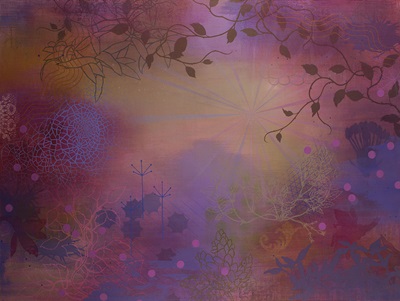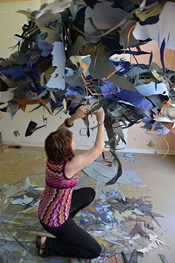Susan Danko (b.1961)
Abundance, 2022
Commissioned by Summa Health
Materials: Acrylic on three canvases (triptych), each 36" x 36"
Location: Juve Family Behavioral Health Pavilion, Second Floor Lobby
About the Art

This triptych builds upon themes Susan Danko first explored in her Woodland Narrative series (2015), inspired by the native plant life found at the edges of Cuyahoga Valley National Park. Through a careful balance of representation and abstraction, Abundance presents an environment where plant species thrive, inviting viewers to appreciate both their beauty and resilience.
Danko employs two primary approaches in her depiction of plant life: silhouetted forms rendered in a single color, akin to stencils, and delicately outlined botanical elements that suggest depth and movement. The colors and relative scale of the plants are intentionally abstracted, chosen not for realism but to evoke serenity. Each plant appears in its most vibrant state—timeless and flourishing, rather than bound to a single season. This effect is heightened by Danko’s masterful use of light. A brightened central composition draws the eye toward focal elements, while the canvas edges, painted white, reflect ambient and artificial light, creating the illusion that the work is illuminated from within.
The title, Abundance, reflects an optimistic perspective on nature’s richness. Trees, shrubs, flowers, and even plants often dismissed as "weeds" are given equal prominence, reminding us of the remarkable biodiversity just beyond our doorsteps. Viewers may recognize specific species—maple, lobelia, echinacea, locust, cinquefoil, and various ferns—painted with both precision and a fluid grace that suggests gentle movement. Yet, each form is also universal, representing an entire plant type rather than a single specimen.
At its core, Abundance is not just a celebration of nature’s vitality but also a quiet call to awareness. Danko’s work often intertwines artistic expression with environmental consciousness, urging us to recognize, appreciate, and protect the natural world. This theme, echoed in her previous works, serves as a reminder that the landscapes we admire are fragile—and that conservation is an essential part of preserving their beauty for future generations.
Multiflora, 2015
Materials: Acrylic on canvas, 36” x 48”
Location: Summa Health – Akron Campus, Main Building (141 N. Forge St.), Purple Neighborhood, Ground Floor near "T" Elevators
A Summa Health Acquisition
Acquired as part of the Summa Health System – Akron Campus Wayfinding Project, Multiflora contributes to an environment designed for clarity, comfort, and engagement. Its color palette and dynamic composition align with the healing and navigational goals of the space.
About the Art

Susan Danko’s Multiflora immerses viewers in an intricate natural world where swirling clouds of purple, violet, and muted gold set the stage for sharply defined vines, shrubs, and flowers. Along the canvas edges, a delicate web of interwoven plant life pulses with energy, culminating in a subtle yet emphatic burst of light in the distance. The composition evokes both movement and stillness, offering a layered exploration of nature’s complexity.
The title, Multiflora, references the multiflora rose—an invasive species that forms dense thickets, crowding out native plants and disrupting ecosystems. This theme of nature’s delicate balance is central to Danko’s work, which often examines the unintended consequences of human impact on the environment.
Beyond its specific reference to the multiflora rose, the title suggests a broader commentary on invasive species and ecological change. Danko’s artistic practice extends into both two- and three-dimensional works that address environmental concerns.
This tension between visual appeal and underlying fragility is a hallmark of Danko’s work. She captures nature’s vibrancy while simultaneously hinting at its vulnerability—reminding us that even the most striking landscapes may conceal hidden threats. This nuanced perspective earned her a 2020 artist residency in Shenandoah National Park, where she continued to explore the intersection of beauty and environmental awareness.
Through Multiflora, Danko encourages reflection on the natural world’s resilience and fragility, reinforcing Summa Health’s mission to create spaces that inspire healing, contemplation, and connection.
About the Artist

Susan Danko is an accomplished artist whose work explores the natural world through a dynamic and immersive approach to painting. She earned her B.F.A. from the Cleveland Institute of Art and has been recognized for her artistic excellence, receiving Individual Excellence Awards from the Ohio Arts Council in both 2013 and 2021. Danko has also participated in a summer residency at the Fine Arts Work Center in Provincetown, Massachusetts, and has exhibited widely across Ohio.
Where to See More of Her Work
Beyond her personal website, Danko’s commissioned paintings can be found in several prominent public spaces. In Akron, her work is featured on the ground floor of the Stark State College building. At Northcoast Behavioral Healthcare in Northfield, paintings inspired by the neighboring Cuyahoga Valley National Park enhance the main lobby and waiting areas.
In Cleveland, Danko’s Wetland series (2013), a collection of 14 paintings, is displayed at the main entrance of the Fairview Hospital of the Cleveland Clinic. Her work Groundcover 2 is located in the lobby of the Marriott Hotel in Cleveland, and her designs appear on touchscreens and keycards at the Cleveland Hilton Hotel and Convention Center.
Internationally, Danko’s art is part of the U.S. Department of State’s Art in Embassies program, with a piece displayed at the U.S. Embassy in Tashkent, Uzbekistan. Additionally, in 2013, she was commissioned to create artworks for the Governor’s Awards for the Arts in Ohio.
For more of her work, visit the Cleveland Artist Registry or explore her representation at Bonfoey Gallery in Cleveland.
